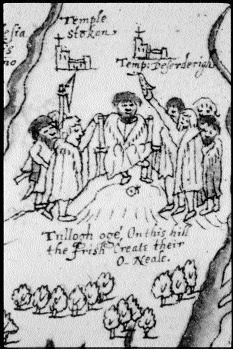Address Cookstown BT80 8UB, UK | ||
 | ||
Similar Beagh, Clonalis House, Donegal Castle, Rathcroghan, Beagh Stone Circles | ||
Ep 50 siege of tullyhogue fort medieval conquest mount blade warband mod
Tullyhogue Fort, also spelt Tullaghoge or Tullahoge (from Middle Irish Tulach Óc meaning "hill of youth" or "mound of the young warriors"), is large mound on the outskirts of Tullyhogue village near Cookstown, County Tyrone, Northern Ireland. It has a depressed centre and is surrounded by trees. It is an ancient ceremonial site where chieftains of the O'Neill dynasty of Tyrone were inaugurated.
Contents
- Ep 50 siege of tullyhogue fort medieval conquest mount blade warband mod
- Tullyhogue fort ni
- History
- Leac na R
- Features
- Today
- References
It is a State Care Historic Monument sited in the townland of Ballymully Glebe, in the Cookstown District Council area, at grid reference: H8250 7430. The inauguration site is a Scheduled Historic Monument at grid ref: H8251 7428.
Tullyhogue fort ni
History
The date of the construction of Tullyhogue fort is not known, however it is believed to have held great significance from early times, possessing a form of ritual importance long before the O'Neills became associated with the site.
Tullyhogue rath was originally associated with the Uí Tuirtri of Airgialla, and then with the O'Hagans between the 11th and 17th centuries. The O'Hagans dwelt at the site and became its hereditary guardians, with their burial place at Donaghrisk situated at the bottom of the hill. In the later medieval period it became the inauguration site of the O'Neill dynasty, where the title "the O'Neill", was bestowed upon each new lord. The inauguration was carried out by the heads of the O'Cahan and O'Hagan. O'Cahan, the O'Neill's principal sub-chief, would throw a golden sandal over the new lord's head to signify good fortune. O'Hagan, being the hereditary guardian of Tullyhogue, would place the shoe on the O'Neill's foot and present him with a rod of office.
Hugh O'Neill's inauguration in 1593[1] was the last such event for an O'Neill to take place at Tullyhogue. The last coronation that is claimed to have taken place at Tullyhogue was that of Sir Phelim O'Neill in 1641, however it was later rejected.
Leac na Rí
The inauguration stone was a large boulder known as the Leac na Rí which mean "the flagstone of the kings". It stood outside Tullyhogue fort, where by the 16th century it had become incorporated into a ceremonial stone chair where three large slabs had been placed around it.
In 1602 during the Nine Years War, Lord Mountjoy, in charge of the English forces at war with Hugh O'Neill, smashed the inauguration stone to symbolically end the O'Neill's sovereignty.
The Leac na Rí is stated as being the Ulster counterpart to the Stone of Destiny, which is now used as part of the coronation chair in Westminster Abbey. The Leac na Rí is also stated as reputedly been blessed by St. Patrick.
Features
The initial impression of Tullyhogue fort is that it resembled an early Christian bivallate rath which was an enclosed homestead surrounded by two banks and ditches. Tullyhogue matches this description in that it has an enclosure 105 ft in diameter that is encircled by two banks. Entry to it was by a causeway in the inner bank. What makes it clear that it was not an enclosed homestead is that the two ditches were built wide apart with a flat area in between, with no outer defensive ditch. The layout of the fort itself shows that it was not built or designed as a defensive structure, but as an area of ceremonial importance.
Today
Cookstown District Council have initiated a tourism plan for visitors and Tullyhogue Fort has become part of its marketing agenda due to its history. During the summer it is a popular tourist destination. In 1998, Don Carlos O'Neill, a Spanish descendant of Hugh O'Neill, started an annual event that takes place in August each year whereby he and his family commemorate the inauguration ceremony of the O'Neills on the spot were his predecessors were crowned.
In February 2007 Cookstown District Council confirmed that the Department of Agriculture and Rural Development (DARD) had agreed to sell the land required to develop Tullyhogue Fort to Council for £90,000.
